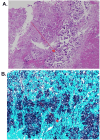Chronic disseminated candidiasis in a patient with acute leukemia - an illustrative case and brief review for clinicians
- PMID: 38448809
- PMCID: PMC10916012
- DOI: 10.1186/s12879-024-09172-9
Chronic disseminated candidiasis in a patient with acute leukemia - an illustrative case and brief review for clinicians
Abstract
Chronic disseminated candidiasis (CDC) is a severe but rarely seen fungal infection presenting in patients with hematologic malignancies after a prolonged duration of neutropenia. A high index of suspicion is required to diagnose CDC as standard culture workup is often negative. While tissue biopsy is the gold standard of diagnosis, it is frequently avoided in patients with profound cytopenias and increased bleeding risks. A presumptive diagnosis can be made in patients with recent neutropenia, persistent fevers unresponsive to antibiotics, imaging findings of hypoechoic, non-rim enhancing target-like lesions in the spleen and liver, and mycologic evidence. Here, we describe the case of an 18-year-old woman with relapsed B-cell acute lymphoblastic leukemia treated with re-induction chemotherapy who subsequently developed CDC with multi-organ involvement. The diagnosis was made based on clinical and radiologic features with positive tissue culture from a skin nodule and hepatic lesion. The patient was treated for a total course of 11 months with anti-fungal therapy, most notably amphotericin B and micafungin, and splenectomy. After initial diagnosis, the patient was monitored with monthly CT abdomen imaging that showed disease control after 5 months of anti-fungal therapy and splenectomy. The diagnosis, treatment, and common challenges of CDC are outlined here to assist with better understanding, diagnosis, and treatment of this rare condition.
Keywords: Chronic disseminated candidiasis; Hematopoietic stem cell transplant; Hepatosplenic candidiasis; Immunocompromised; Neutropenia; Neutropenic fever.
© 2024. The Author(s).
Conflict of interest statement
The authors declare no competing interests.
Figures


Similar articles
-
Clinical characteristics and treatment response of chronic disseminated candidiasis in patients with hematological disorders.Sci Rep. 2025 Apr 15;15(1):12868. doi: 10.1038/s41598-025-97004-4. Sci Rep. 2025. PMID: 40234627 Free PMC article.
-
Hepatosplenic Candidiasis Without Prior Documented Candidemia: An Underrecognized Diagnosis?Oncologist. 2017 Aug;22(8):989-994. doi: 10.1634/theoncologist.2017-0019. Epub 2017 May 3. Oncologist. 2017. PMID: 28469041 Free PMC article.
-
Clinical features and outcome of hepatosplenic fungal infections in children with haematological malignancies.Mycoses. 2020 Jan;63(1):30-37. doi: 10.1111/myc.13002. Epub 2019 Nov 13. Mycoses. 2020. PMID: 31514231
-
Liposomal amphotericin B: a review of its use as empirical therapy in febrile neutropenia and in the treatment of invasive fungal infections.Drugs. 2009;69(3):361-92. doi: 10.2165/00003495-200969030-00010. Drugs. 2009. PMID: 19275278 Review.
-
Response of Symptomatic Persistent Chronic Disseminated Candidiasis to Corticosteroid Therapy in Immunosuppressed Pediatric Patients: Case Study and Review of the Literature.Pediatr Infect Dis J. 2018 Jul;37(7):686-690. doi: 10.1097/INF.0000000000001844. Pediatr Infect Dis J. 2018. PMID: 29140934 Review.
Cited by
-
Cold Atmospheric Pressure Plasma May Prevent Oral Mucositis-Related Candidemia in Chemotherapy-Treated Rats.Int J Mol Sci. 2024 Oct 26;25(21):11496. doi: 10.3390/ijms252111496. Int J Mol Sci. 2024. PMID: 39519048 Free PMC article.
-
Diagnostic and Therapeutic Challenge Caused by Candida albicans and Aspergillus spp. Infections in a Pediatric Patient as a Complication of Acute Lymphoblastic Leukemia Treatment: A Case Report and Literature Review.Pathogens. 2024 Sep 7;13(9):772. doi: 10.3390/pathogens13090772. Pathogens. 2024. PMID: 39338963 Free PMC article. Review.
References
Publication types
MeSH terms
Supplementary concepts
LinkOut - more resources
Full Text Sources
Medical

